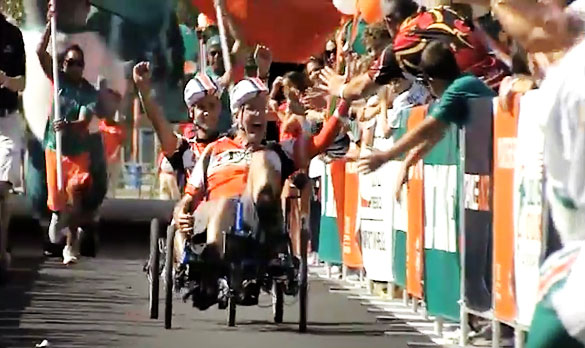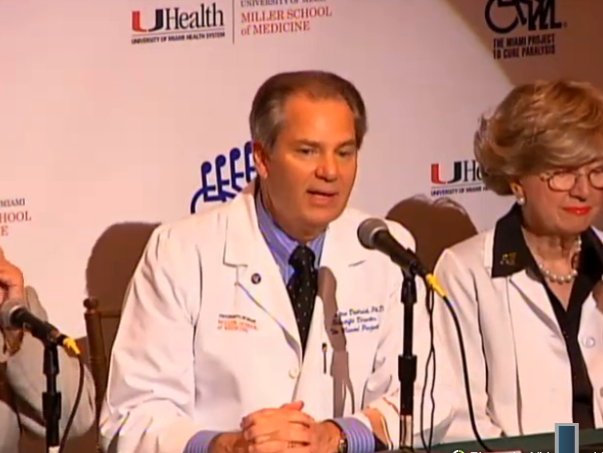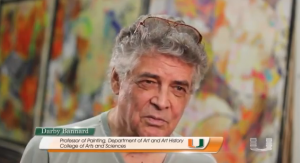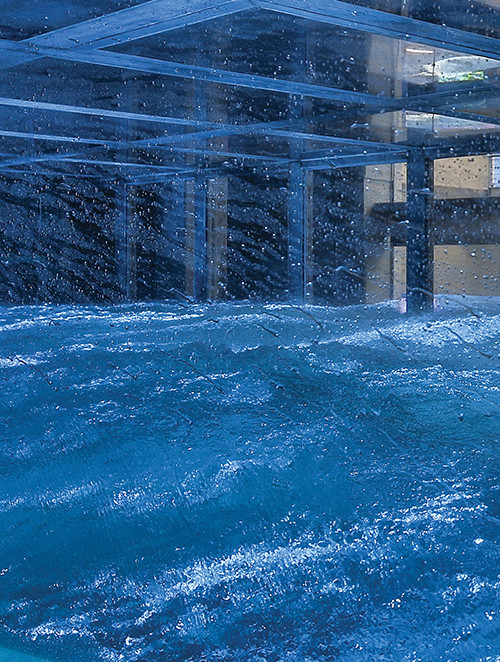
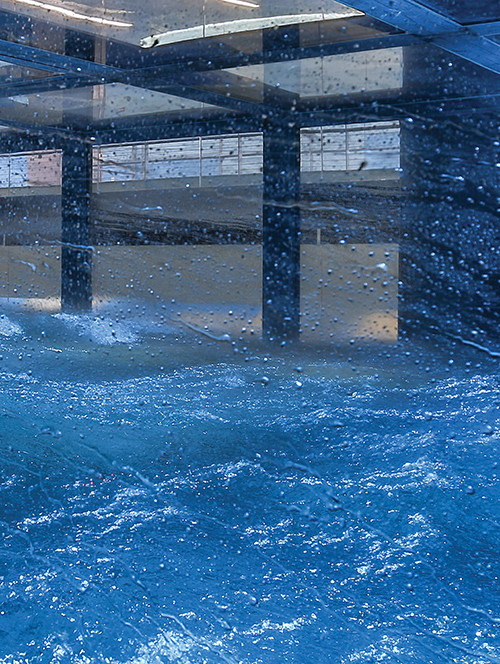

BY ROBERT C. JONES JR.
PHOTOS BY GORT MEDIA GROUP
UM now boasts the world’s only hurricane simulator able to generate
Category 5 hurricane-force winds along with swells and sea spray—simulated
storm conditions that will help researchers solve some of the mysteries
of storms and in the long term save lives.
The little beachfront house took quite a pounding. Towering swells crashed into its wooden stilts, while brutal winds, some exceeding 130 miles per hour, pummeled its outer walls, shaking the home so violently it looked as if it would topple at any second. But remarkably, it stood firm, at least on this day. Tomorrow, and the next day, it would endure much harsher conditions—spawned not by nature but with the flip of a switch.
Tropical cyclones are a regular weather occurrence inside the University of Miami’s new hurricane research facility, the Alfred C. Glassell, Jr. SUSTAIN (SUrge-STructure-Atmosphere INteraction) lab, where scientists can tinker with the controls of a 75-foot-long, 38,000-gallon wind-wave tank to simulate everything from a weak tropical storm to a cyclonic monster complete with 160-mile-per-hour winds, sea spray, and storm surge.
“There’s no other facility like it in the world,” says Brian Haus, professor of ocean sciences at UM’s Rosenstiel School of Marine and Atmospheric Science, where the tank is located.
Haus, who co-wrote the grant proposal that helped UM obtain the federal stimulus money to build the tank, is not exaggerating by any stretch of the imagination. SUSTAIN, he explains, is unique because of its ability to generate Category 5 wind speeds (157 miles per hour or higher) over water.
Before SUSTAIN, that had never been done before in a lab. A 1,400-horsepower fan, originally designed to ventilate mineshafts, makes it all possible, generating the powerful winds that travel across the seawater pumped into the tank.
During a demonstration for media last spring, just as the Atlantic hurricane season got underway, Haus stood along the sides, underneath, and on top of the all-acrylic tank, observing the torrent of waves and sea spray rushing through. That test-run was proof of another unique aspect of the tank—its width (20 feet) and height (6 ½ feet) allow 3-D simulation modeling and the observation of crosswinds.
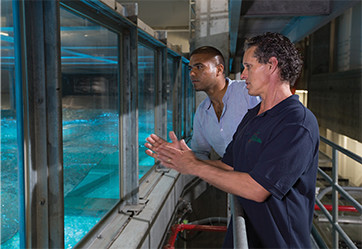
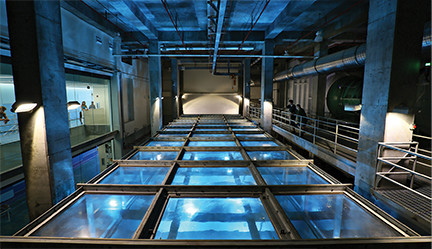
A topside view of SUSTAIN. Professor Brian Haus, right, and Ph.D. student Sanchit Mehta watch the wave action.
It’s all being done in the name of science, of course, with the ultimate goal of saving lives. By simulating and observing storm conditions in the tank, researchers hope to solve some of the mysteries of tropical cyclones that have puzzled meteorologists and forecasters ever since they started tracking them—such as why some storms intensify at an incredible rate. One need only review recent history to learn how fast storms can strengthen.
During the record-breaking 2005 Atlantic hurricane season, Hurricane Wilma went from a tropical cyclone to a Category 5 hurricane in just 24 hours—its wind speed soaring from 70 to 175 mph. As Hurricane Charley approached Florida’s west coast in 2004, its sustained winds jumped from 110 to 150 mph in only three hours. And in 2007, Felix increased from a meager tropical depression to a Category 5 hurricane in 51 hours.
Haus knows better than anyone how quickly hurricanes can bulk up. Five years ago during a research expedition off the coast of Taiwan, he and a team of scientists left port to retrieve a group of buoys they had deployed in the western Pacific to record data from two super storms that passed over the area. Before they could reach their instruments, a third cyclone, Typhoon Chaba, suddenly intensified and changed direction, pummeling them with 30-foot swells.
“We don’t know completely what causes hurricanes to rapidly intensify,” says Haus. “Track forecasting has gotten better and better, but intensity forecasts have not improved, and one of the possible reasons for that is we don’t fully understand what’s happening where the ocean and atmosphere meet in really high winds.” It is that critical air-sea interface that SUSTAIN will measure.
Two of the potential culprits for rapid intensification Haus plans to zero in on: sea spray and bubbles. Whipped up by the violent, swirling winds of a hurricane, the two have long been a thorn in the side of researchers trying to determine their effect on storm intensity. While difficult to measure during an actual storm, sea spray and bubbles are easily observed under conditions created by SUSTAIN.
“They may be responsible for transferring a lot of the latent heat, and what really drives a storm is the heat that gets up in the upper levels of the storm,” explains Haus. “But because of a bunch of complicated feedback loops and different things that happen right at the surface, we really don’t understand how much sea spray and bubbles contribute to intensification. So we have a chance to address some pretty fundamental questions there.”
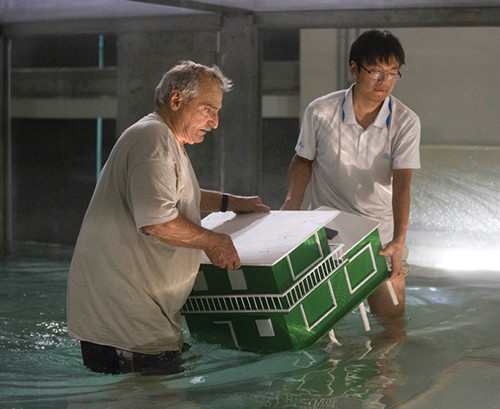
Technician Mike Rebozo, left, and Ph.D. student Ming Shao place a scale model house inside the tank during a demonstration. Photo:AP Photo/Wilfredo Lee
Forecasters and scientists at the Miami-based National Hurricane Center are just as excited as Haus over the potential of the Rosenstiel School’s new indoor hurricane simulator. Often on the frontlines of hurricane and storm system tracking and warnings, NHC staff stand to benefit most from the tank’s capabilities, using the data it produces to improve forecasting, which in turn will aid emergency management officials issuing hurricane evacuation orders.
Mark DeMaria, chief of the NHC’s Technology and Science Branch, believes SUSTAIN will help his colleagues in two ways. “When we’re forecasting tropical cyclones, we need to monitor the systems and know what the maximum wind speed is,” says DeMaria. “We do that with a combination of things. In the Atlantic we have aircraft maybe only 30 percent of the time. Meanwhile, satellites in low-earth orbit will send down a microwave signal, and it looks at the backscatter (the reflection of waves back to the direction of their origin) from the ocean and can deduce the wind speed from that.
“There’s some theory that shows you what the backscatter means in terms of wind speed,” he continues. “But it’s very difficult to get in that environment in a storm to find out what’s really going on. So, with the wave tank’s ability to go up to high wind speeds, it should help to refine those space-based measurements to make them more accurate.”
The facility, according to DeMaria, could also improve forecasting. “You can only go so far with theory,” he says. “What you’d really like to do is get some actual observations. But it’s difficult to put sensors in the middle of a major hurricane. The tank provides a way to simulate that process and actually take measurements of the fluxes to refine forecast models.”
Because hurricanes often make landfall on shorelines with high-rise buildings, and with more and more of our coastal regions coming under the threat of rising sea levels caused by climate change, SUSTAIN is expected to play a major role in helping engineers and architects to design stronger and safer structures located near water.
Much like the scaled-down beachfront house that was placed in the tank earlier this year as a demonstration for media getting their first look at the tank, UM structural engineer Antonio Nanni, who studies how all kinds of structures perform under extreme conditions, has elaborate plans for SUSTAIN—from studying the effect of Category 5 wind speeds and massive storm surge on near-shore high-rises, to analyzing what effect prolonged winds and waves have on sea-based oil rigs and bridges over bodies of water.
Nanni, the co-principal investigator of SUSTAIN, will also use his scale-model simulations to validate existing computer modeling.
“We have the ability now to conduct experiments we just couldn’t do before,” says Nanni, professor and chair of the Department of Civil, Architectural and Environmental Engineering and head of the College of Engineering’s Materials and Structures Lab. “The Rosenstiel School already had a smaller wind-wave tank, but it couldn’t simulate shoreline conditions. Now, we can.”
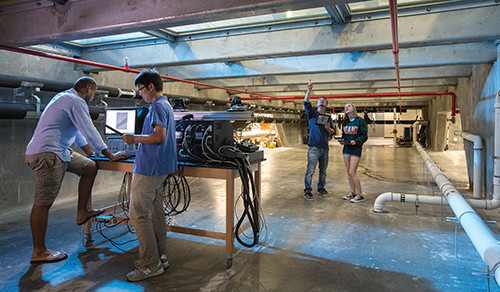
The tank allows observations from underneath, where researchers can easily record data.
Grants through the National Institute of Standards and Technology (NIST) and the Department of Homeland Security to conduct such experiments are already in the pending stages, according to Haus.
And at least one UM researcher already has obtained valuable data from SUSTAIN and put it to good use. When Professor of Ocean Sciences Tamay Ozgokmen and his team deploy their specially made drifters in the Gulf of Mexico in January 2016, they’ll be fairly confident that their instruments will yield valuable ocean-current data that will help determine what happens to crude after an oil spill at sea.
That’s because Ozgokmen and his team tested one of the drifters in the tank for three days a week from last November to March, observing how it performed under different oceanic conditions and then modifying its design so that it would operate within parameters. The process wasn’t easy, Ozgokmen admits. “It was very much like designing a car. A car is very much affected by wind and is designed to be aerodynamic to maximize its efficiency. We faced a similar challenge with the drifters,” he said, noting that his team had to factor in wind and wave speeds as well as ocean currents to simulate as closely as possible the movement of oil over water.
They used SUSTAIN to achieve that task, testing the drifter in tank conditions that mimicked breaking waves, turbulent seas, and calm waters. Now, the drifter is being mass produced, and 1,000 of the biodegradable buoys, equipped with GPS devices that can transmit data every five minutes for up to six months, will be dropped into the Gulf near the site of the Deepwater Horizon explosion. The experiment is part of an ongoing study to predict the fate of oil released into the environment, one of the missions of the Consortium for Advanced Research on Transport of Hydrocarbon in the Environment (CARTHE) that Ozgokmen directs.
Other researchers, some of them from overseas, have expressed interest in using SUSTAIN for testing, says Haus. Once they do, they will experiment with a high-tech wind-wave simulator unlike any other, one with 12 individual wave panels that can create almost any type of ocean environment—from multiple waves, long or short swells, waves that crash into each other, and even run in opposite directions.
“There’s a million things we can do with this tank, and the longer we play with it, the more things we discover we can do with it,” says Mike Rebozo, a senior technician at the Rosenstiel School who helps maintain the tank. The simulator, which can go up to 60 hertz, requires such tremendous electrical power to generate hurricane-force conditions that a generator must be used to run the tank whenever its power output surpasses 15 hertz.
SUSTAIN is one part of the $45 million Marine Technology and Life Sciences Seawater Complex on the Rosenstiel School campus. The building’s Marine Life Science Center is home to a National Institutes of Health-funded Aplysia lab, billed as the only facility in the world that cultures and raises sea hares for scientific research in aging, memory, and learning. Other research is being conducted on coral reefs and species such as toadfish and zebra fish in hopes that such investigations will improve human health.
The Glassell Family Foundation supported the construction of the wind-wave tank portion of the complex, but it was a $15 million stimulus grant from NIST that got the ball rolling on SUSTAIN, one of only a handful of proposals funded by the agency. “We picked only the best of the best,” said Mary Saunders, NIST associate director for management resources, at the tank’s dedication last October.
During that ceremony, she recalled that NIST led a technology team to the devastated regions in the Gulf Coast in the wake of hurricanes Katrina and Rita to examine and better understand just what caused buildings and bridges to fail. “In the coastal regions and in New Orleans, we would have benefited from the data and measurements that will result from this research facility,” said Saunders. “I firmly believe it was money well spent.


 Follow
Follow


